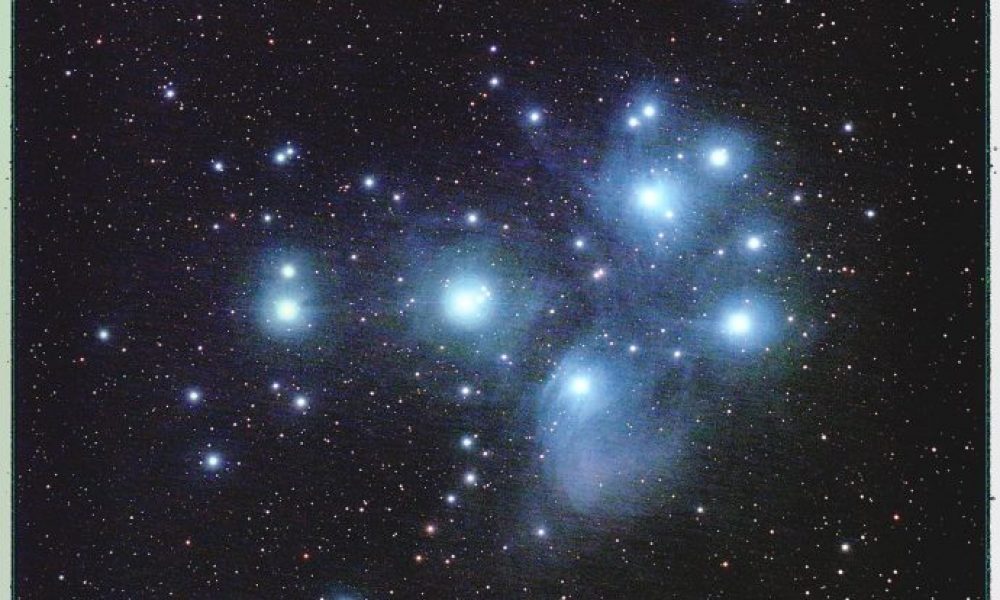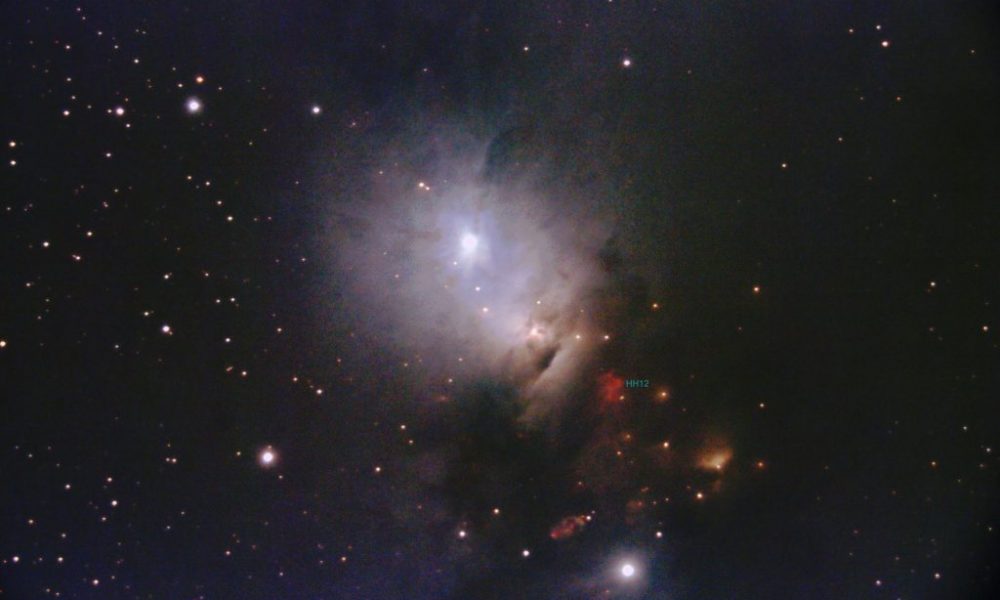Lookout Observatory shows you Herbig-Haro objects, probably for the first time in your life!
Dear Lookout Observers,
If you can find a place with a clear view of the sky around this time of year (early February), and at about 8 PM you face south and look about 2/3 of the way up, you would be looking at the part of the sky shown in the first picture. If you are lucky enough to have very dark skies, the view would be similar to this picture, but without the fainter stars and faint red nebulosity. It is a large piece of sky, almost 60 degrees high and 40 degrees wide. The very top of the picture is directly overhead. Just above center is the bright, yellowish star Aldebaran, brightest star in the constellation Taurus the bull. To the lower left is the constellation Orion the hunter, with his belt of 3 stars and his sword hanging below containing the famous Orion Nebula. In the opposite direction from Aldebaran, to the upper right is a bright star cluster, the Pleiades. Even in light-polluted skies, you could probably still see the Pleiades, Aldebaran, and the brightest stars of Orion. Above the Pleiades, at the very top, is a small red streak known as the California Nebula. It shows clearly in this 25-minute time exposure, but you cannot see it with your naked eye, and it is difficult to see even in a telescope. And finally, notice the small blue box I have drawn near the upper right corner. A close up of this area will be our 4th and most interesting picture. All of the objects featured in this bulletin are within our Milky Way galaxy.
The second picture is a close up of The California Nebula taken with a 420mm telephoto lens instead of the 14mm wide-angle that was used for the first picture. This nebula consists of hydrogen gas about 1000 light years away caused to glow red because it is energized by the bright star below it in the picture. This star is a blue giant, 30 times the mass of the sun, and (including ultraviolet light) is over 1/4 million times as bright as the sun.
The third picture is a close up of the Pleiades taken with the same 420mm telephoto. This is a cluster of stars that formed together about 100 million years ago. The brightest members are all hot young blue stars. The nebulosity around them is caused by their blue light being reflected off of the interstellar dust cloud that they are currently moving through, about 440 light years away. For old time Lookout Observatory fans, more about this cluster was discussed in the February 18, 2015 bulletin.
The fourth picture – taken through a telescope with a 1950mm focal length, a much larger scale than the previous photos – is a close-up of the area within the blue box on the first picture. It is NGC 1333, a cluster of stars immersed in hydrogen gas and dust. It is located about 770 light years away The blue is caused by the reflection on dust of light from large bright blue stars; the red is caused by heated, glowing hydrogen gas beginning to form into new stars; and the dark regions are caused by dense dust blocking the light of stars and gas behind it. If you want to see this as just a colorful picture and leave it as that, that is fine. This report is becoming awfully long!
But if you want to understand more, read on! Giant molecular clouds are the largest objects within galaxies, sometimes several hundred light years across. They contain vast amounts of cold gas and dust, largely molecular hydrogen and helium with small amounts of heavier elements. One such cloud, which lies in the direction of the constellation Perseus, is known as the Perseus molecular cloud and is about 80 light years across. Molecular clouds are where stars are born! Star formation occurs through gravitational contraction in the densest parts of these clouds, and NGC 1333 is the most active region of star formation in the Perseus cloud. It contains hundreds of newly formed low-mass stars less than a million years old.
In stellar formation, as gravitationally contracting gas heats up enough to create a balance between the outward radiation pressure and the inward gravitation, it becomes known as a protostar. Since there are usually eddies of disturbance in the gaseous cloud, additional infalling material spirals in because of the angular momentum from the eddies. As more material from the surrounding molecular cloud pours into the protostar, it may develop narrow jets of fast-moving partially ionized gas at the two poles of the spinning protostar. This fast moving gas is expelled into the surrounding clouds of gas and dust, causing shock waves which cause the energized emission of red light from hydrogen gas, and the result is called a Herbig-Haro object (named after two of the early students of these objects). This shock-induced phenomena is a transient phase of star formation, which typically lasts only a few tens of thousands of years. However, sometimes changes in brightness in the surrounding nebulosity can be seen by professional astronomers in as little as just a few years.
Just above and to the left of the brightest star near the bottom of the image is a string of small red blobs. These are HH (for Herbig-Haro) 7, 8, 9, 10, and 11. Above and slightly right of these is a slightly brighter red blob, identified as HH12. These objects are numbered in order of discovery, so these are some of the earliest identified. HH1 was identified in 1946, and over 1000 have been discovered by now. It is estimated that there may be as many as 150,000 of these objects in our galaxy.
Now you can impress your friends by saying that you have actually seen a Herbig-Haro object! (You don’t have to tell them it looks like just a tiny red blob.)
Keep looking up,
Carter, (sometimes) Resident Astronomer,
Lookout Observatory
Thanks to my niece Nicole Balzer, who inspired my interest in star formation details by asking for my help with her college astronomy class. Most information here comes from Wikipedia and from: NGC 1333: A Nearby Burst of Star Formation by J. Walawender et. al., inHandbook of Star Forming Regions Vol. I, Astronomical Society of the Pacific, 2008, Bo Reipurth, ed.










